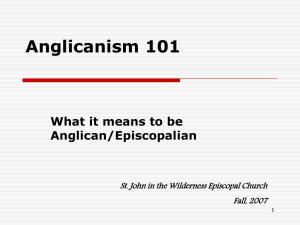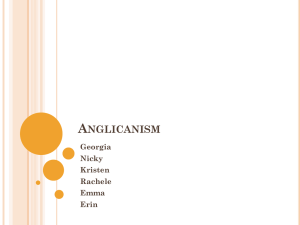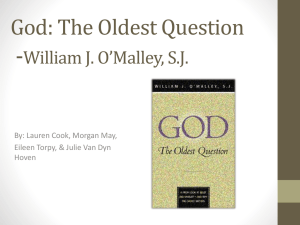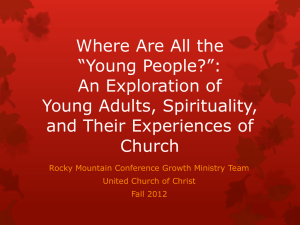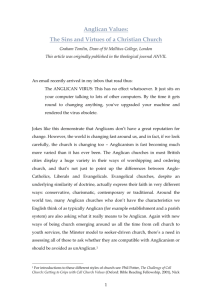What is Anglicanism? - Church of the Savior
advertisement
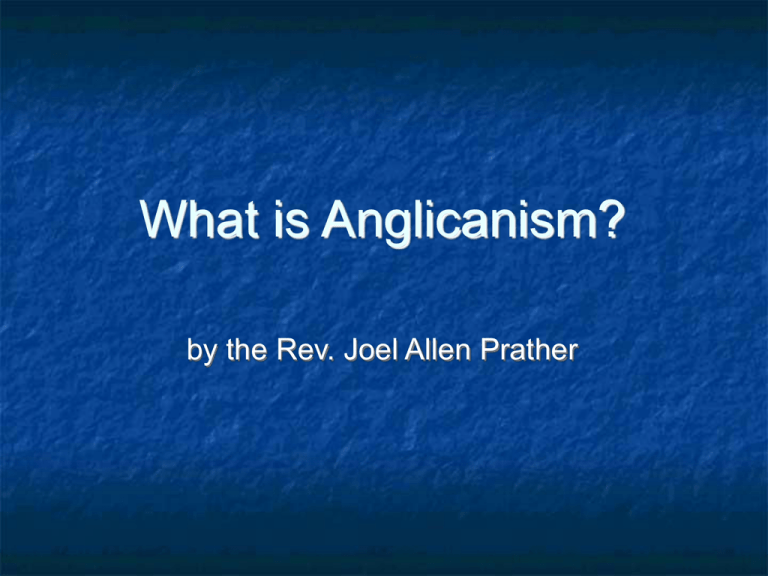
What is Anglicanism? by the Rev. Joel Allen Prather Catholic? Protestant? Yes! The Real QuestionS “Did the Anglican Church begin with the Protestant Reformation or earlier?” “Wasn’t it started because the King wanted a divorce?” What is Anglicanism? “The Anglican Way was not created in the sixteenth century since the Ecclesia Anglican [English Church] had existed for many centuries; but it took particular shape, form and content in the middle of the sixteenth century.” What is anglicanism? “Anglicanism has never considered itself to be a sect or denomination originating in the sixteenth century. It continues without a break the [English Church] founded by St. Augustine thirteen centuries and more ago, though nowadays that branch of the Church has spread far beyond the borders of England.” Christianity Arrives in England First Mention of Christians in Britain… “… all the limits of the Spains, and the diverse nations of the Gauls, and the haunts of the Britons – inaccessible to the Romans, but subjugated to Christ.” ~ Tertullian circa 200 A.D. Also mentioned by Origen circa 240 A.D. The Church is established in England by the 4th century British bishops attended the Council of Arles (France) in 314A.D. and… Assented to the decisions of the Council of Nicaea in 325 A.D There are documented bishoprics in London, York and Lincoln circa 300 A.D St. Alban CIRCA 304 a.d. “In this country occurred the suffering of St. Alban…” ~ the Venerable Bede First individual Christian named in England The Martyrdom of St. Alban The evangelization of the british isles “Not Angles, but angels!” Pope Gregory the Great, 540-604 A.D. St. Augustine of Canterbury 597-664 A.D. The evangelization of the british isles The evangelization of the british isles St. Aidan of Lindisfarne d. 561 A.D. “Whether in town or country, he always traveled on foot unless compelled by necessity to ride; and whatever people he met on his walks, whether high or low, he stopped and spoke to them. If they were heathen, he urged them to be baptized; and if they were Christians, he strengthened their faith, and inspired them by word and deed to live a good life and to be generous to others.” ~ the Venerable Bede Origins of Celtic Christianity Hallmarks of Celtic Christianity v s . Hallmarks of Celtic Christianity vs. Hallmarks of Celtic Christianity vs. Hallmarks of Celtic Christianity v s. The Synod of Whitby circa 664 A.D. The Synod of Whitby The Synod of Whitby “The strands of Irish and continental influence were interwoven in every Kingdom and at every stage of the process by which England became Christian.” Anglican Identity “But by choosing in favor of Rome, the Church of England brought herself in touch with the blood-stream of the Catholic Church and could henceforth play her full part in the life of Christendom.” Anglican Identity Independent Nationalistic Devoted to the Faith of the universal Church Biblical Missional FAST FORWARD TO th THE 16 CENTURY The Reformation The Church has existed in England since the 3rd century with its unique character (independent, nationalistic, “Catholic”, biblical & missional) however… “it took particular shape, form and content in the middle of the sixteenth century.” But… What About Henry’s Divorce? Henry’s Divorce is Merely a Symptom “The Reformation in England, however, had a different character. The appeal had an important political twist: we will resist papal authority partly because of papal corruptions, but, to no small degree, because we will not be subjected to any foreign authority, temporal or spiritual.” English Hearts and Minds “In his own inner life the average Englishman of the later Middle Ages was undoubtedly deeply religious…the English as a whole were a religious nation and impressed visitors as such. Moreover they were becoming more educated and more intelligent…This educated laity formed an important element among those who were conscious of abuses and keen for reform. Men were aware that big changes were taking place – social, economic, national and international – and were anxious to see a Church alive both to its responsibilities and opportunities.” Henry says good-bye to rome “Although concern for religious reform and national interests underlay the motivation for an independent English church, it was Henry’s well-known desire to shed Catherine of Aragon in order to marry Ann Boleyn that precipitated the break with Rome.” What about the divorce? Unique Features of the English Reformation While the Church in England was asserting its independence it was also declaring its devotion to the historic Faith and Practice. Parliament “made it clear that the Church in England was anciently and would continue to be the Church of England” and that it had no intention to “decline or vary from…the ancient Catholic faith of Christendom.” Unlike the Continental Reformers, the Church of England’s Reformation was not a radical Reformation which put away anything resembling the Roman Church. So what did the English Reformation look like? “What do Anglicans believe?” ► “The Church of England reformed the medieval form of Catholicism which it inherited, and it reformed itself by the Gospel…Unlike Protestant Churches in Switzerland and Scotland, however, the Church of England maintained the Catholic Order of the Threefold Ministry, government by bishops (under the godly monarch), and the Catholic tradition of an authorized liturgy.” 38 “What do Anglicans believe?” 39 “What do Anglicans believe?” ► “Anglicanism is not a theological system and there is no writer whose work is an essential part of it either in respect of content or with regard to the form of its self-expression…The absence of an official theology in Anglicanism is something deliberate which belongs to its essential nature, for it has always regarded the teaching and practice of the undivided Church of the first five centuries as a criterion.” 40 One Canon …of Scripture ► Testament ► Apostle’s Creed Nicaea I 325 A.D. Two Testaments Old Testament New Three Creeds Nicene Creed Athanasian Creed Four Councils Constantinople I Ephesus Chalcedon 381 A.D. 431 A.D. 451 A.D. Five Centuries 41 The thirty-nine Articles ► “They give with exactness, balance, and fulness the supreme voice of our Church on all matters covered therein.” 42 The thirty-nine articles “Though The Thirty-Nine Articles of Religion as a Statement of Faith has a similar taste, feel and look to the Confessions of Faith produced by the Lutheran and Reformed (Presbyterian) Churches, it does not have precisely the same role and function as they. This doctrinal statement is not to be regarded as the stand-alone Confession of Faith of the Church of England…(it) is one formulary of three” along with the Book of Common Prayer and the Ordinal 43 The thirty-nine articles ► Articles ► ► ► I—VIII: The Faith Articles I – V articulate the Creedal statements concerning the nature of God, manifest in the Holy Trinity. Articles VI and VII deal with Scripture Article VIII discusses the essential Creeds. 44 The thirty-nine articles ► Articles IX—XVIII: Personal Religion ► ► “Dwell on the topics of sin, justification, and the eternal disposition of the soul. Of particular focus is the major Reformation topic of justification by faith. The Articles in this section and in the section on the Church plant Anglicanism in the via media of the debate, portraying an Economy of Salvation where good works are an outgrowth of faith, and there is a role for the Church and for the sacraments.” 45 The thirty-nine articles ► Articles ► XIX—XXXI: Corporate Religion “This section focuses on the expression of faith in the public venue – the institutional church, the councils of the church, worship, ministry, and sacramental theology.” 46 The thirty-nine articles ► Articles XXXII—XXXIX: Miscellaneous ► ► These articles concern clerical celibacy, excommunication, traditions of the Church, and other issues not covered elsewhere. 47 Richard hooker 1554-1600 A.D. ► “The Via Media” and the “Three-Legged Stool” 48 The three-legged stool ►Scripture ~ Tradition ~ Reason ► ► “What Scripture doth plainly deliver, to that first place both of credit and obedience is due; the next whereunto is whatsoever any man can necessarily conclude by force of reason; after these the voice of the Church succeedeth. That which the Church by her ecclesiastical authority shall probably think and define to be true or good, must in congruity of reason over-rule all other inferior judgments whatsoever.” 49 ► ~ Of the Laws of Ecclesiastical Polity The three-legged stool 50 Via Media ► Hookers Laws were a defense of the Church of England against both Puritanism and Roman Catholicism and he “sought to bring peace after much strife.” 51 Episcopacy ► “…the office of a bishop in the (Anglican) church represents a partial continuation of the office of an apostle.” 52 Suggested Reading 53 Suggested Reading ► The Anglican Formularies and Holy Scripture by Peter Toon ► Our Anglican Heritage ► by John W. Howe 54 Suggested Reading ► Looking At The Episcopal Church ► by William Sydnor ► An Introduction to the Episcopal Church ► by J.B. Bernardin 55 Suggested Reading ► Beyond Smells & Bells: The Wonder and Power of Christian Liturgy ► by Mark Galli ► The Prayer Book Through the Ages ► by William Sydnor 56 Suggested Reading ► A History of the Church in England ► by J.H.R. Moorman ► ► The Ecclesiastical History of The English People ► by the Venerable Bede 58
